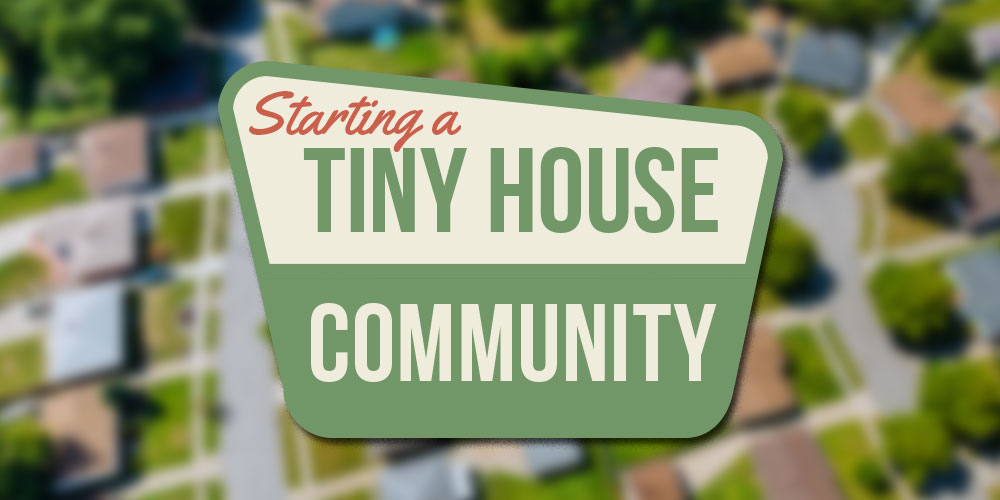
NAVIGATION
Imagine not worrying about paying rent, growing food on your property, having enough outdoor space for your dog and kids to play, and knowing your neighbors deeply enough to call them friend. If that sounds too good to be true, you’re in the right place!
Tiny house lovers are taking things to the next level by upgrading to entire neighborhoods. Shared social experiences, reduced cost of living, time outside with loved ones, freedom, and authentic connections are just a few reasons why people may want to start a tiny house community of their own.

Hi, I’m Ryan
Over the last decade, I’ve uprooted my life in the corporate world and exchanged it for a tiny lifestyle. My tiny house has given me benefits that have changed my life. Tiny communities bring you all the benefits of living in a tiny house, but allow you to experience them in a community with others.

Why Live In A Tiny House Community?

In the isolated social culture of our media age, people long for honest connection. Something I love about tiny house culture is it gets back to communal life that used to be commonplace.
 In the agrarian era, farming was the central focus of society; that work took up most of the day. As a result, people spent most of their time with the same people, and social communities naturally formed.
In the agrarian era, farming was the central focus of society; that work took up most of the day. As a result, people spent most of their time with the same people, and social communities naturally formed.
Today, a lot of our work is individualized and, thus, our lives are too. Tiny house communities are a way to get back to that down to earth, harmonious way of living. They put you in close proximity to your neighbors, allow you to depend on each other for resources, involve outdoor activities, and create spaces to bond.
You Truly Know Your Neighbors In Tiny House Communities
I think people today are craving the kind of camaraderie that tiny house communities foster. It’s one of the main reasons communities fill up so quickly. The culture in a tiny house neighborhood is drastically different from inner-city or suburban life — it’s much more personal.
 Knowing your neighbors intimately is a given. Instead of interacting with your neighbors every once in awhile when you need someone to dog sit, you’ll run into them when you grab your mail in your pajamas, drink your coffee on your porch, or head out the door for work.
Knowing your neighbors intimately is a given. Instead of interacting with your neighbors every once in awhile when you need someone to dog sit, you’ll run into them when you grab your mail in your pajamas, drink your coffee on your porch, or head out the door for work.
If you’re looking for total privacy, these villages may not be for you. Life in a tiny community means close quarters and daily interactions with other families. However, this hospitable camaraderie is a main reason people are drawn to tiny house communities.
You Have Financial Freedom In Tiny House Communities
Living in a tiny house has reduced my cost of living substantially, which makes it a huge pull for tiny communities. For one, you aren’t responsible for monthly rent or under the control of a landlord if you’re a part owner. Additionally, your utility bill is going to be much lower than if you lived in a traditional home.
It’s also common practice in these communities for people to share on food costs, cook meals for one another, host neighborhood potlucks, or share produce they’ve grown themselves — reducing money spent on food overall. Neighborhoods also regularly host activities collectively, which are open to everyone, so there is less need to spend on entertainment.
Life Happens Outdoors In A Tiny House Community
Because of this, much more happens outside the house than in a traditional neighborhood, which is phenomenal for your health physically, mentally, and emotionally. Experts say time outside improves your quality of life, and these tiny housers really live that out.

Tiny House Villages Are Eco-Friendly
Environmental consciousness is a given in tiny house communities. Tiny homes require fewer materials to build and less energy to power, heat, and cool compared to traditional single-family homes.
Additionally, shared resources and meals, the utilization of communal spaces, solar panels, and a tendency to depend on one another for daily needs like carpooling and borrowing supplies reduces the carbon footprint of members in tiny house communities.
How To Start A Tiny House Community In 8 Steps

Starting your own tiny house community takes more than just a bunch of friends with a dream. You’ll need donors, the right location, an understanding of building laws, and more to start your village off on the right foot. You’ve got to start somewhere, so let’s dive in!
1Set Goals For Your Tiny House Community
The process of starting a tiny house community is going to vary greatly depending on what your goals are, so you need to solidify your vision before making any concrete plans.
People start tiny house communities to:
- House their own extended family
- Create an intentional living community
- Rent tiny homes out as Airbnbs
- Give tiny homeowners long-term parking
- Build energy-efficient housing alternatives
- Offer alternate housing in a housing crisis
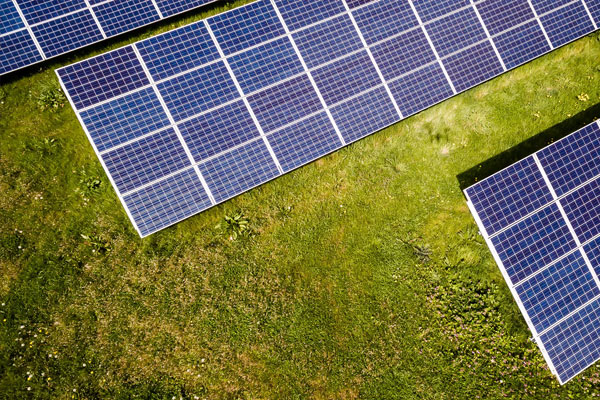
If any of these reasons sound like the intention you have in mind for your tiny house community, think about what that means for the planning and design process. You aren’t going to design or plan for each of these reasons in the same exact ways.
2Find A Location For Your Tiny House Neighborhood
Choosing the ideal location is important when considering how to start a tiny house community. You want to foster a positive environment. A community forms via the bonding of likeminded people, so you want to grow your village in a city where you naturally connect with the type of people who live there.
Do some in-depth research on different cities and towns, and what life looks like there to scope out the ideal location for your community. Think about the type of people you hope to attract and scope out places where the social culture matches your intent. Again, keep your intent in mind to help inform your research.
3Read Tiny House Building And Zoning Laws In Your City
You also can’t just plop a tiny house community anywhere — there are rules for where these neighborhoods are actually allowed to be. Reading the fine print of building and zoning laws is vital if you want to set up a community like this.
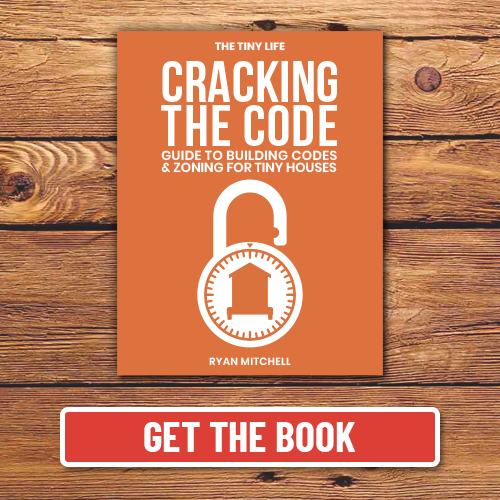 Rural land restrictions tend to be less involved, with less building codes and less staff to enforce them. Cities and counties typically have minimum dimensions for single-family dwellings, so how small you’re allowed to build your home varies.
Rural land restrictions tend to be less involved, with less building codes and less staff to enforce them. Cities and counties typically have minimum dimensions for single-family dwellings, so how small you’re allowed to build your home varies.
City building laws are more involved, and many of them aren’t quite up to date when it comes to accommodating tiny homeowners. However, just because you can’t find tiny house-specific laws in your city, doesn’t mean building a tiny house community is prohibited where you are.
I’d suggest consulting an expert like a local build and design company in your area to help you understand the fine print for laws in your city before breaking ground. Or, check out our state builder’s directory to find information on tiny house building laws in each US state.
4Gather Support To Fund Your Tiny House Village
Unless you’ve been saving awhile already, you’ll need to rely heavily on funds from other people to get a project like this off the ground. This can come from donors, investors, or simply encouraging your community residents to come together to split the cost of the project.
The co-housing movement is growing rapidly as today’s housing prices are steadily increasing. There are several legal structures in place to support the co-housing movement and make it possible to split costs with your peers. Some co-ops will also have a labor system where residents put in their time, labor, and skillsets to benefit the intentional living community and help reduce overall costs.
 Every intentional community does things differently when it comes to ownership. It’s going to depend on what your purpose is for the village and whether or not you intend to have members buy the land and tiny house, rent the property, or invest in the project. For example, check out the in-progress Tongass Tiny Home Village in Alaska where the creators are using different investment packages for members to choose from to cover costs.
Every intentional community does things differently when it comes to ownership. It’s going to depend on what your purpose is for the village and whether or not you intend to have members buy the land and tiny house, rent the property, or invest in the project. For example, check out the in-progress Tongass Tiny Home Village in Alaska where the creators are using different investment packages for members to choose from to cover costs.
You’ll also need to budget wisely. You have to know how much you need in order to spell the costs out accurately for community members. This can get dicey, because projects like this span huge price ranges. Again, this goes back to your purpose and planning. You would need to budget a tiny neighborhood for your relatives in an entirely different way than a community you’re building to rent out tiny houses.
The best way to get a ballpark idea of your tiny home community cost is to find someone who has done something similar. Scope out projects that mirror your vision. Then, identify what you’re willing to spend on your project — is the cost of these similar projects comparable? You may need to amend your vision to get the support you’re seeking.
Consider the following costs when planning a tiny house community:
- Land
- Tiny house shells
- Trailers
- Design services
- Building services
- Land use permits
- Building permits
- Landscaping
- Water infrastructure
- Electrical connects
- Vehicle management
- Waste management
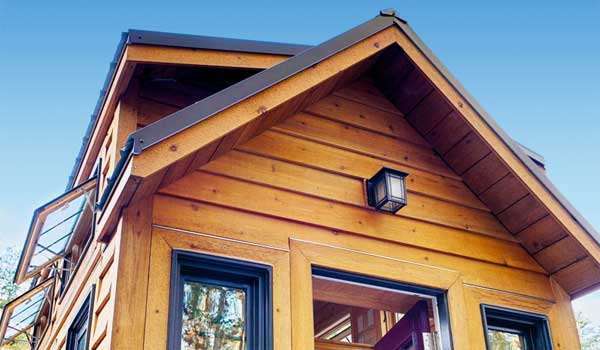
I’ve worked in the tiny community for over a decade, and too often I see people put all their eggs in one basket only to have their project fall off the map. Without proper planning, people often just decide they can build their dream tiny house village for an unrealistic amount of money, and it’s simply not possible.
Wise planning, however, can actually bring your vision to fruition! Your dreams are attainable if you pair the passion and idealism with practicality from the early planning stages.
5Get Permits Your Tiny Village As A Neighborhood
The next step is to figure out what permits you need to get your tiny house neighborhood legally registered. Consider land permits, building permits, and the subject of registering your community as a neighborhood or RV park through your municipality.
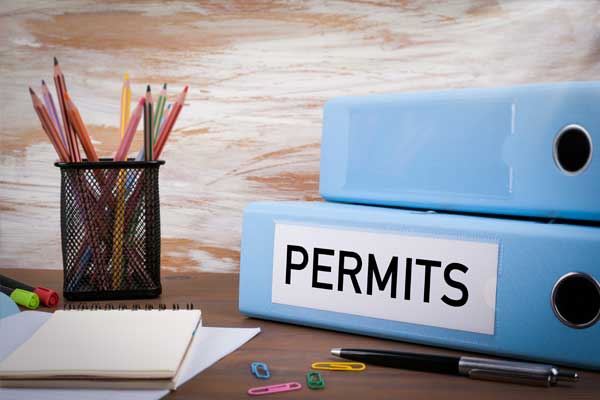 Building permits and land permits will be managed differently depending on where you live. Typically, permits are issued by local government agencies through which you’ll get approval. Here’s an example of a land permit from Santa Barbara, California. A simple google search can help you find out which department to contact about permits in your jurisdiction.
Building permits and land permits will be managed differently depending on where you live. Typically, permits are issued by local government agencies through which you’ll get approval. Here’s an example of a land permit from Santa Barbara, California. A simple google search can help you find out which department to contact about permits in your jurisdiction.
You’ll also need to register the tiny village as a legal rental property, neighborhood, RV park, or whatever designation fits best. This is a process you can complete through local government agencies. Depending on how you’re registering the village, you’ll likely seek out the department of transportation or department of community engagement.
6Build Your Tiny House Community
Once you’ve jumped through all the proper hoops to get your tiny house community set up, you can start building! Again, there’s a lot to consider when you’re ready to break ground.
Consider your budget and what that means for the building process — are you going to DIY the tiny houses and utility installation yourself? Or are you planning to hire a professional design and build team? Defer to our builder’s directory to find tiny home builders in your state.
Your design dreams are also a huge part of bringing your tiny house community to life. We’ll look at some example community layout ideas later in this post.
7Find Your Tiny House Community Members
A tiny house community without community members will not stand. To start a tiny house neighborhood, you’ll need residents to live in your village, so get the word out! Posting online or creating a website for your tiny house community is a valuable way to find people who might want to live there.
You’ll also need to design a membership process that works for your vision. How do you want to go about accepting members into your community? There are several approaches — here are some common routes:
Common Membership Options
- Co-op housing
- Communal housing
- Renting to tenants
- Selling land plots and houses
- Selling land plots for tiny homeowners to park
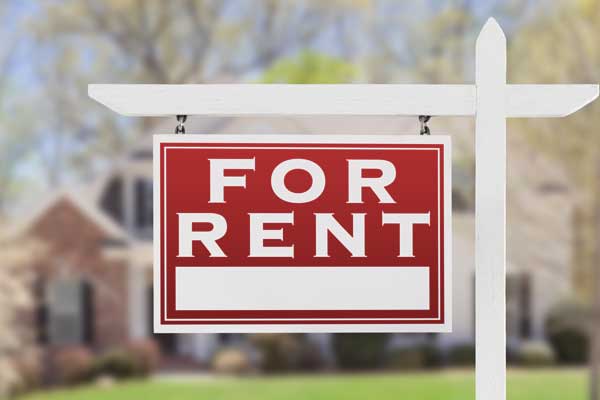
With co-op housing, each member of the community owns part of the project and decisions are made together like a team or family unit. While the co-op method may sound utopian, it can be hard to execute in the modern world. If the community doesn’t agree on core decisions like how to spend savings or use resources, the whole project can break down quickly. Psychologically, the co-op method is more likely to go smoothly with a smaller group.
Most of my friends who own tiny house communities have gone the renting and leasing routes because it’s easiest for them to manage effectively. It’s also the easiest way to get devoted investors, because investors know tiny home communities with a monthly rent will fill up and are more inclined to commit.
Most tiny house communities create an application process to approve renters and residents. That process can be as general or in depth as you see fit, but having some sort of screening process before accepting members is wise so that the character of the community matches your heart’s intent for the project. Check out Sunset Meadows in Trenton, Texas, for an example of how to set up applications.
8Move Into Your Tiny House Neighborhood
When your tiny house community is all set up, it’s time to move in and start your new life with your neighbors! Enjoy a communal life in your outdoor hammock, reading in your tiny house loft, and playing outside with neighbors and pets. Lean into the idyllic existence that mirrors how humans were meant to live.
Starting A Tiny House Community: Potential Setbacks

If you want to learn how to start a tiny house community, you might face some setbacks along the way. Addressing those obstacles early on helps you get in front of them to make your development process as smooth as possible. Let’s look out how to conquer any challenges you may face building a tiny house village.
Legislative Restrictions On Tiny House Communities
The most common obstacle that could get in the way of the tiny house community you desire is issues with building or zoning laws. Depending on where you live, you’ll undergo a different process to get a community approved.
You may have to present your project to a planning committee to get it approved entirely, or simply follow the building laws already in place and make sure your community does not break any zoning or building laws. If a tiny home is not legal in your jurisdiction, you may want to consider joining an existing community to avoid the headaches, or seek another locale.
Tiny Home Villages Face Disapproval From Those Who Live In The Area
When creating your own tiny house community, you may face backlash from current homeowners in the area who do not understand what tiny homes are. There’s a stigma around RV parks, and pre-existing neighborhoods don’t always want them nearby.
But just because a tiny house community may be coded or zoned as an RV park, that does not mean the concerns residents in surrounding subdivisions have will be present. Regardless, you may face pushback from the community who fears and misunderstands your tiny home village, so just be aware of that.
Setting Up Utilities In A Tiny House Community Takes Work
You may also face challenges setting up utilities on the land you’re using for your tiny community. It can be a hard process, especially for someone without construction experience. But don’t lose heart! I built my own tiny house from start to finish without having any construction experience of my own. It took a while, but I was able to learn from experts as I went.
You’ll need to answer these basic utility questions that apply to the location of your neighborhood to inform what kind of utilities you need.
Basic Utility Questions
- Is there a water supply nearby you can connect to?
- Will your tiny houses need water tanks?
- Are your tiny homes mobile with RV hookups?
- Are you required to connect to the city septic line?
- Will you need to install a septic tank?
- How will you get electricity?
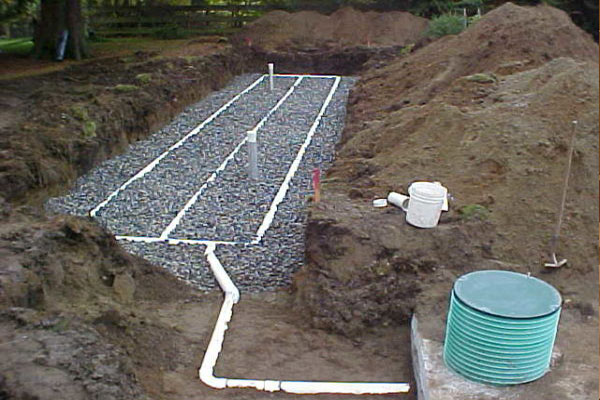
Tiny House Community Design Ideas

One of the most important elements when it comes to starting your own tiny house community is the design. Check out these tiny house village plans to help you create the neighborhood that works best for you and your residents.
Tiny Home Community Plans For Twelve Families
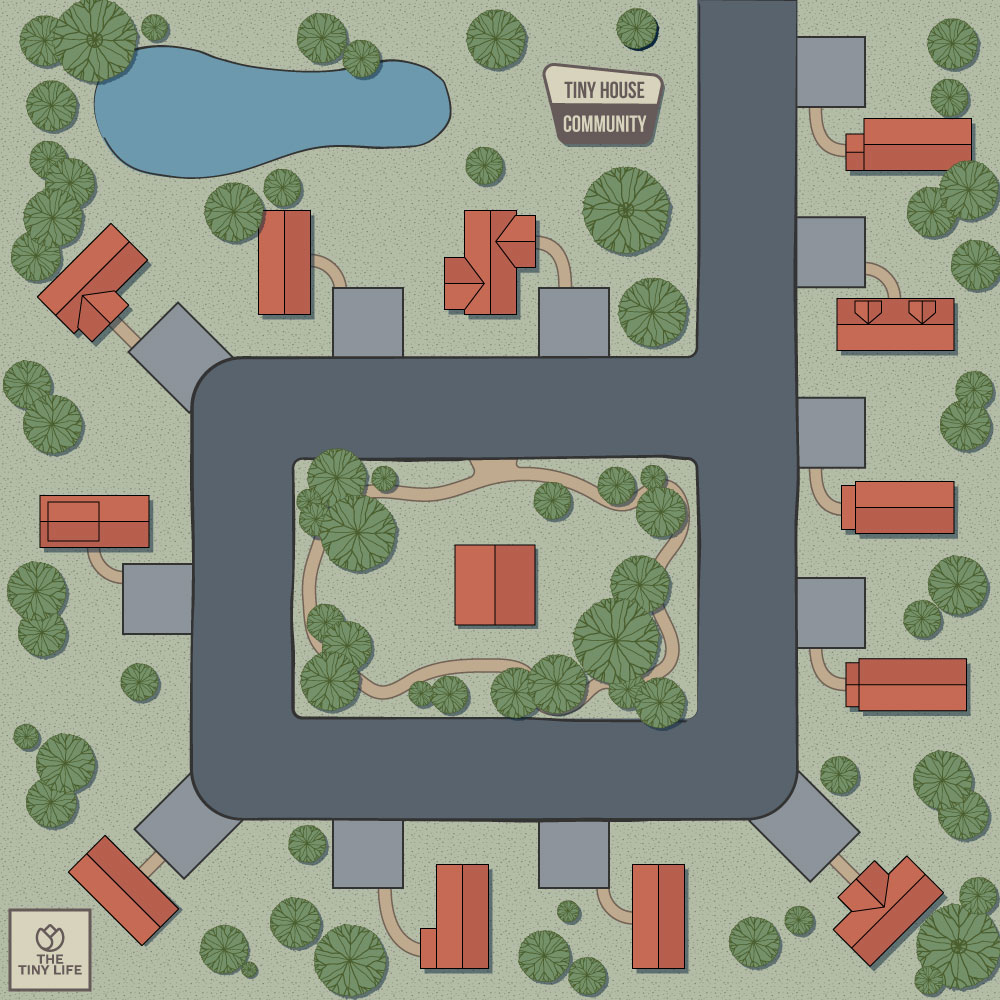
This layout is set up to include 12 tiny houses centered around a communal space in the middle. The communal space can be used for lots of different activities like group meals or game nights. Each house has its own driveway connected to the house.
Tiny House Neighborhood Layout For Families
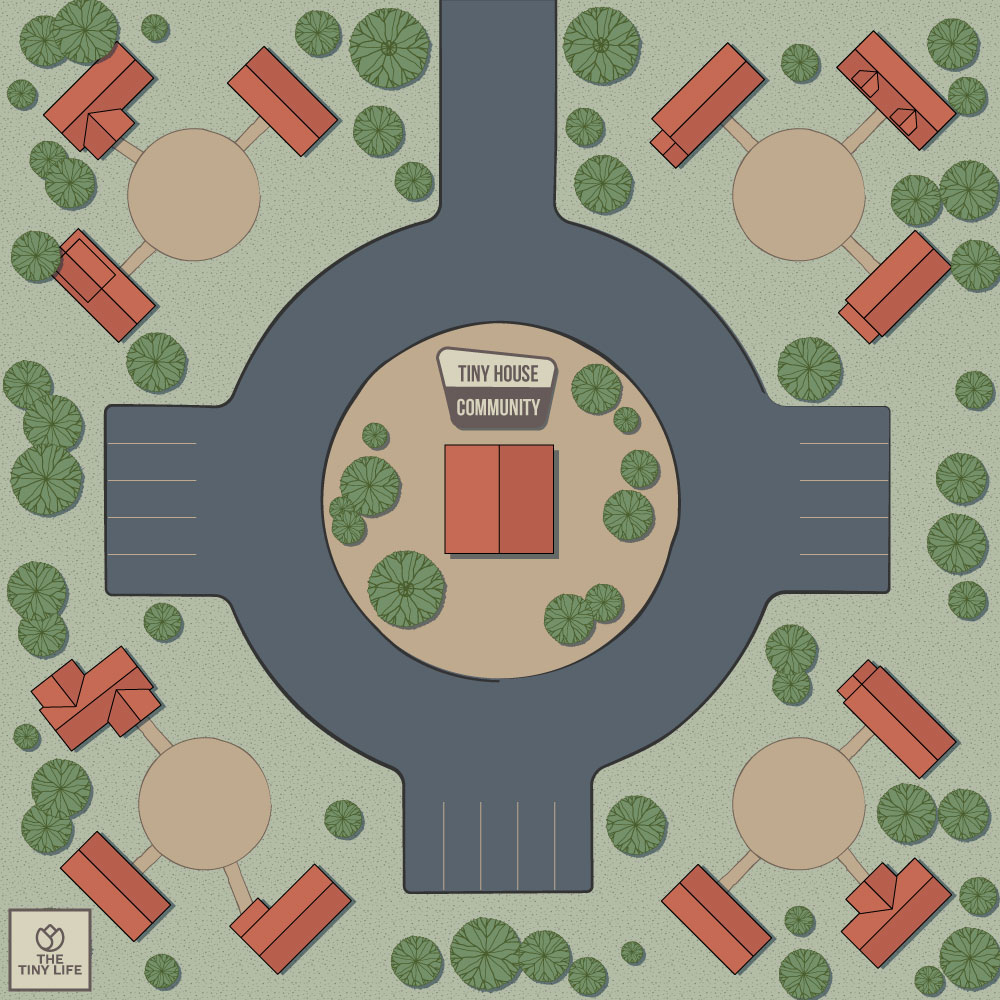
Ideal for multiple families who want to live together in a tiny home village, this layout includes 12 homes which each surrounding their own cul-de-sac. This is helpful if you still want to maintain a sense of privacy while living in your tiny house community. The homes also surround a central community building.
Tiny House Community Design With Parking Lot
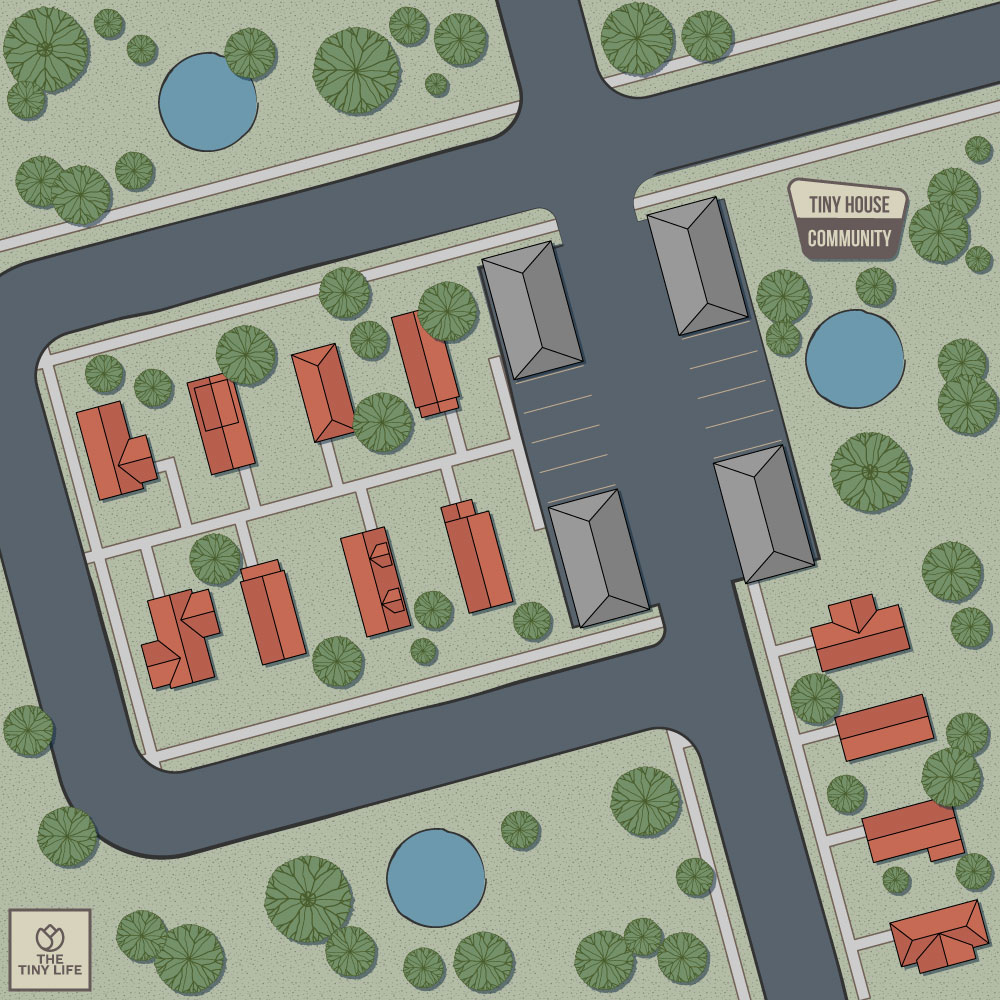
If you are seeking a tiny house neighborhood that is welcoming to visitors, you may want to include a parking lot in your plans. This tiny house village layout is set up similarly to an apartment complex, with each building next to the other and a parking lot with covered and uncovered parking in the middle of the community.
Tiny House Village Layout With Covered Patios
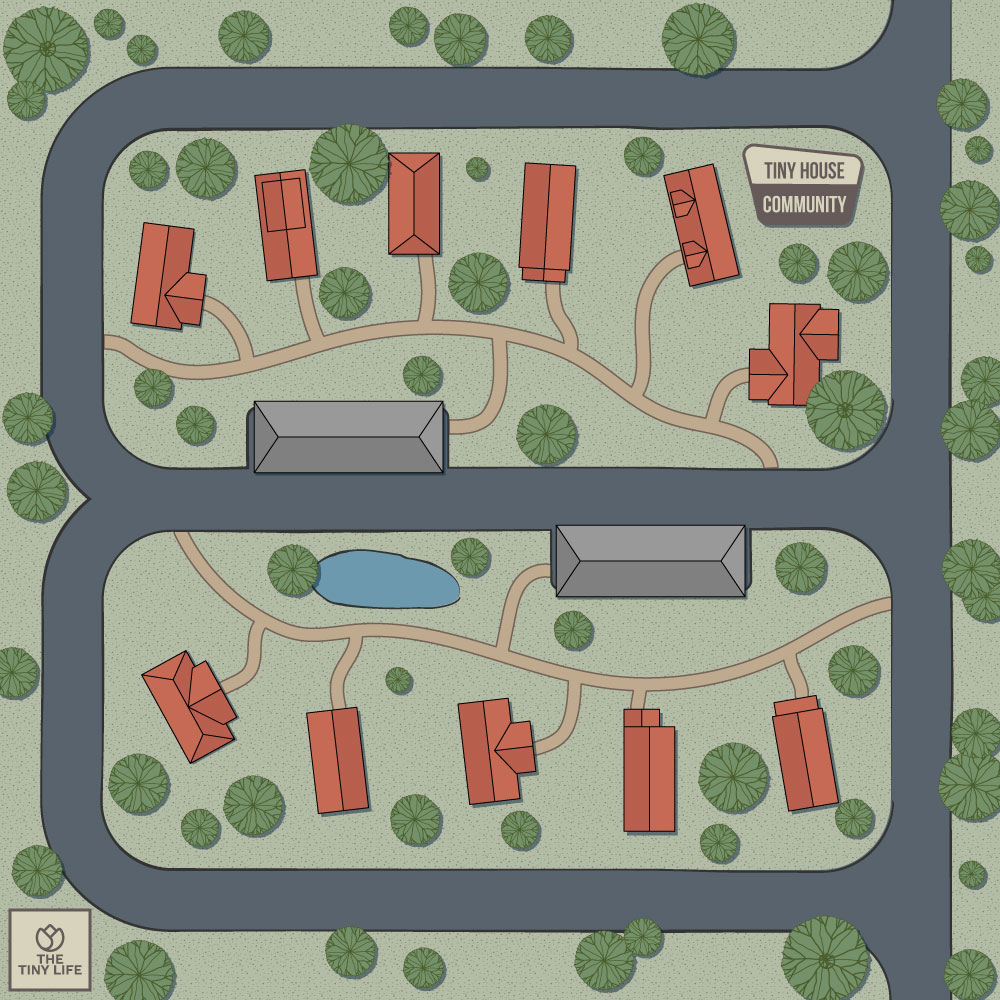
This tiny home neighborhood has each of the 12 tiny homes fairly spread out, leaving room between them for larger yards. It also includes a covered outdoor space on each side of the street which you and your neighbors could use for community cookouts, bonfires, or picnics.
Tiny House Neighborhood Map With Parking Lot And Swimming Pool
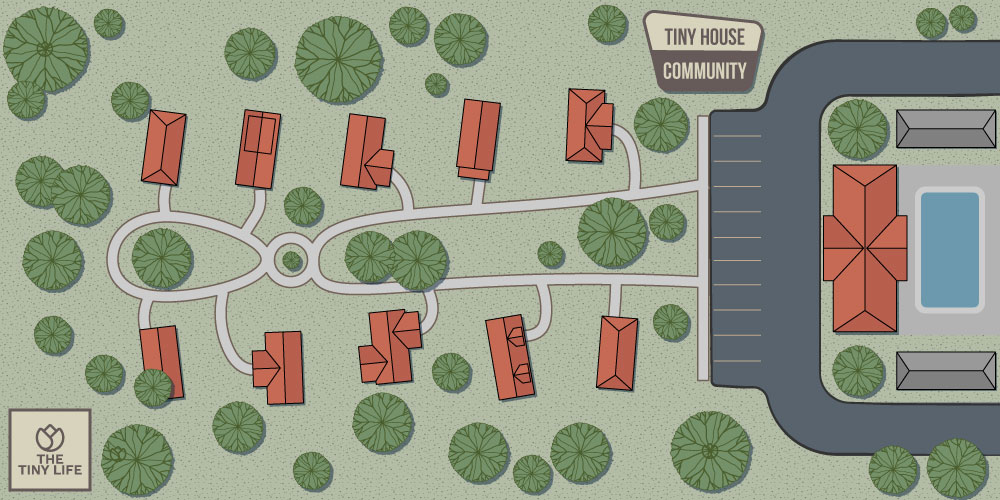
If you’re seeking a tiny house community layout that spreads each house out substantially while also having a spacious area for community activity, this might be the layout for you. The community area on the far-right side of the plot has room for a swimming pool and two covered patios to bring the community together and connect with one another.
Tiny House Community Blueprint For 44 Tiny Homes
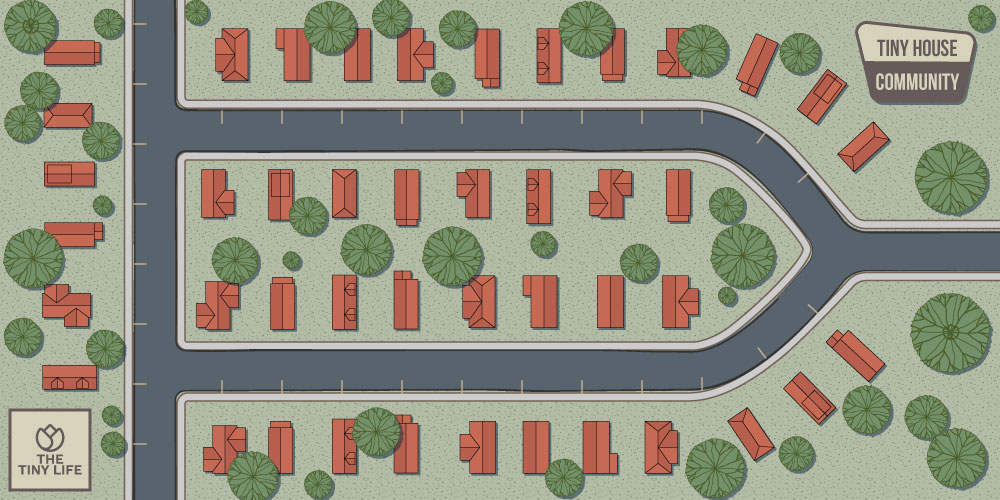
Not all tiny house villages are meant for just a few residents. Many developers have dreams of creating tiny house neighborhoods that closely mirror subdivisions. This community layout has room for 44 tiny houses as well as a yard and parking spot for each home.
Tiny House Village Design Surrounding A Lake
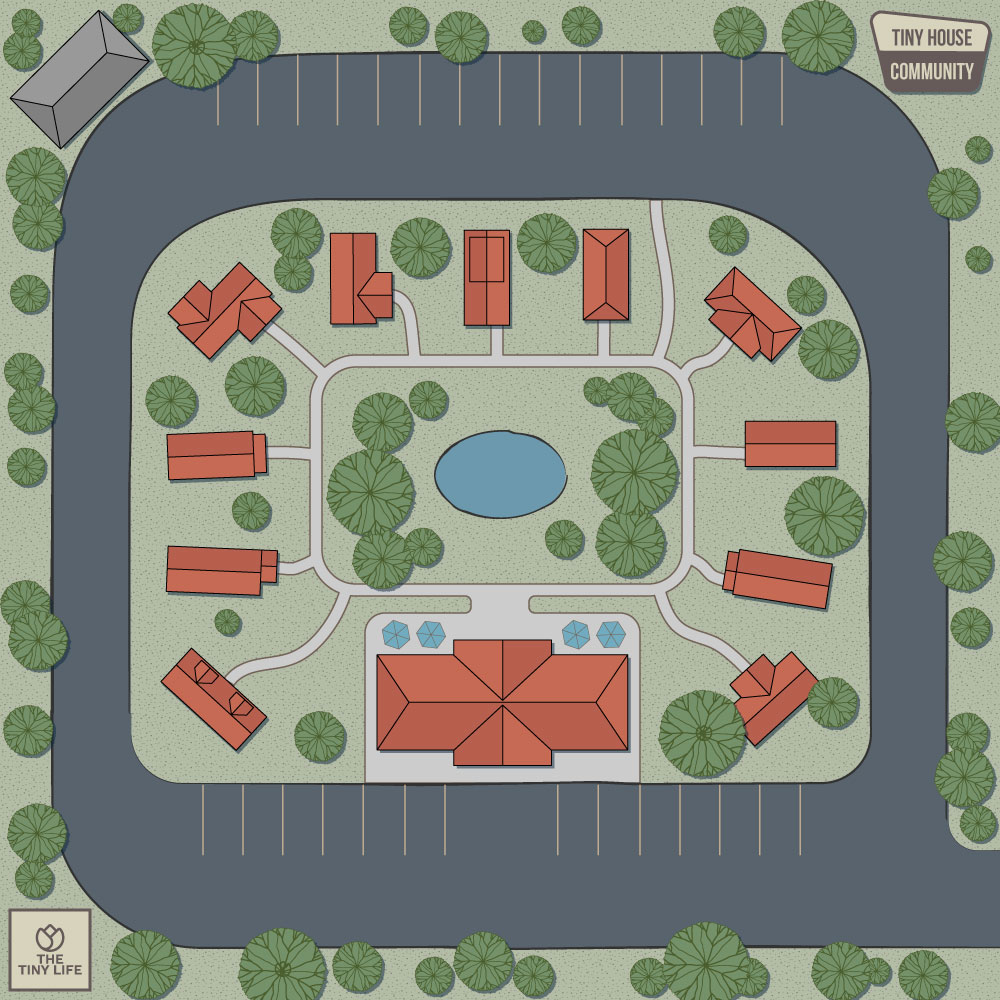
A communal, intimate feel is the focus of this layout. All of the tiny houses face each other and are angled around a lake at the village center. This setup also includes a community center which can be used for a vast number of purposes that best serve your tiny community.
Tiny House Neighborhood Plans
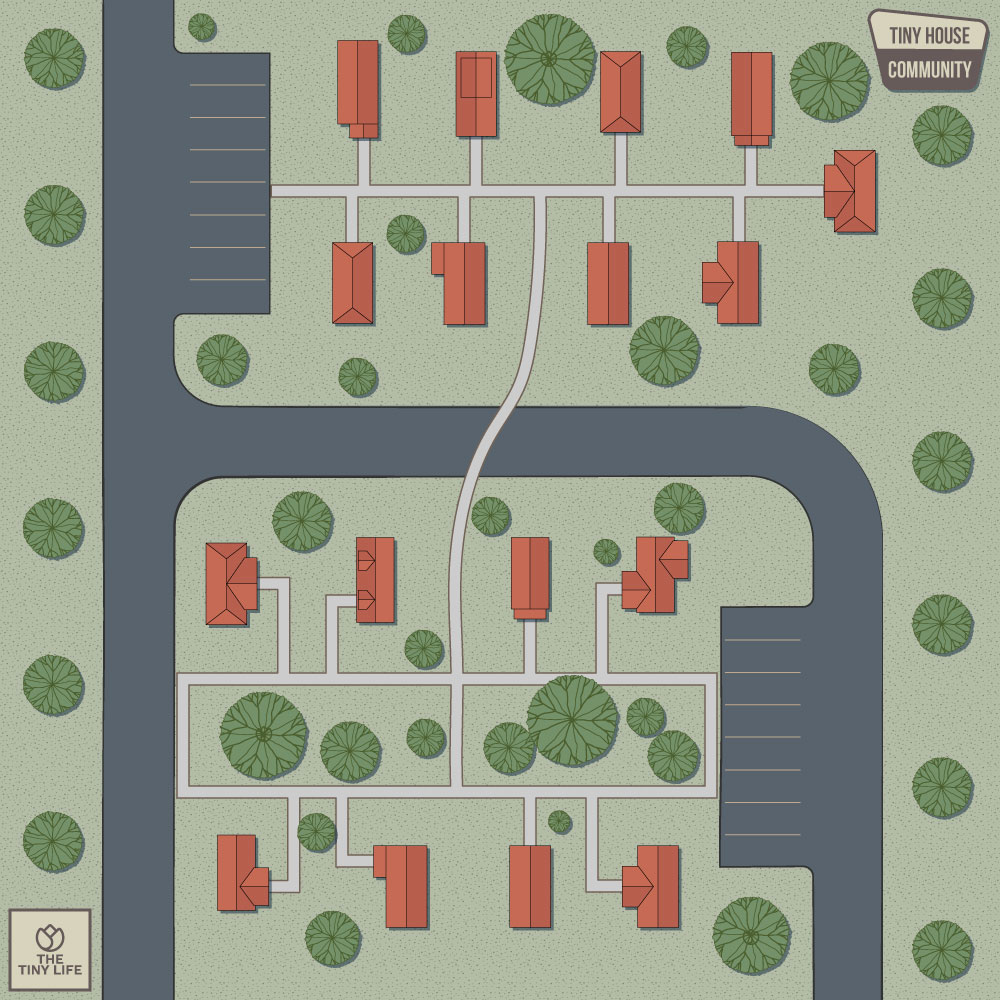
This layout is set up the way a traditional neighborhood might be setup, except with parking lots at the end of the street instead of next to each individual home. The tiny houses sit across from one another to foster casual camaraderie amongst the community.
Tiny House Village Map For Eight Families
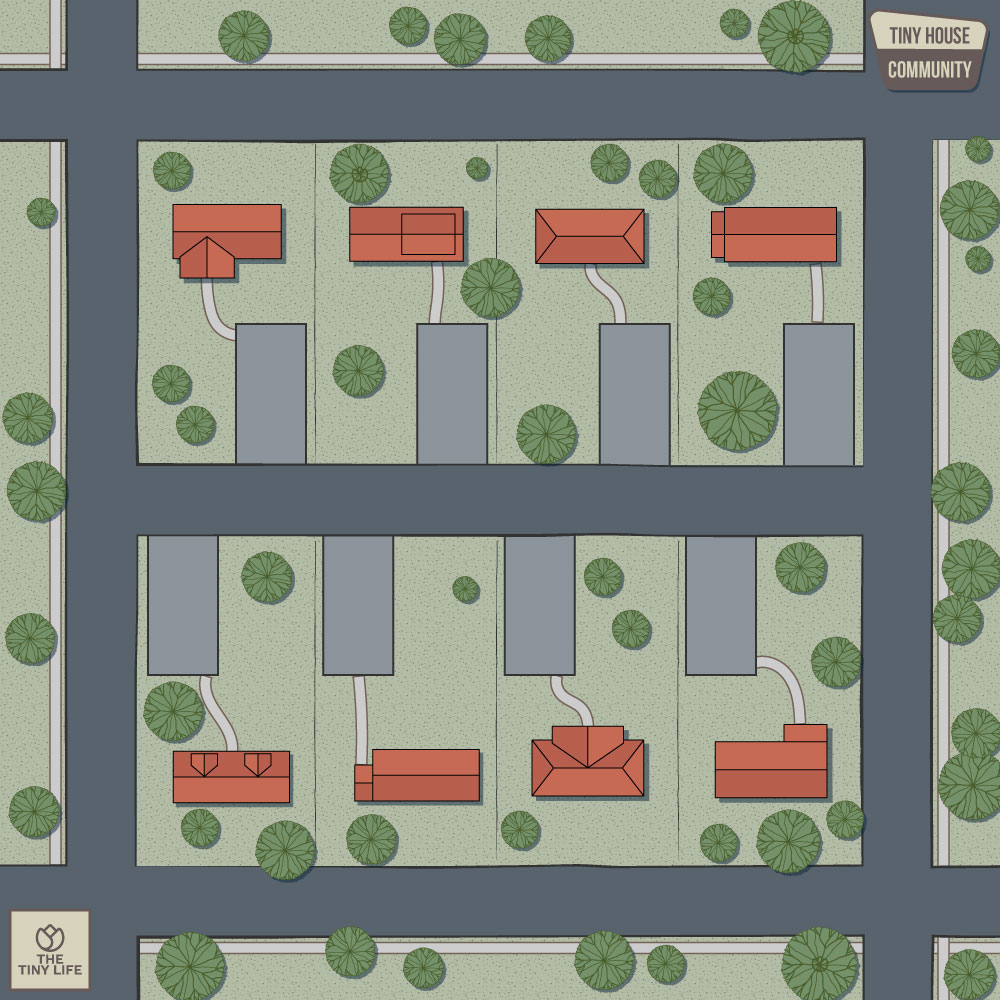
If you are seeking a tiny house community that still feels private and separate, consider this layout. The setup allows each resident to have room for their own backyard, front yard, and parking space, just like in a traditional subdivision. The only differentiating factor is the size of the homes.
Tiny House Community Blueprints With Lake
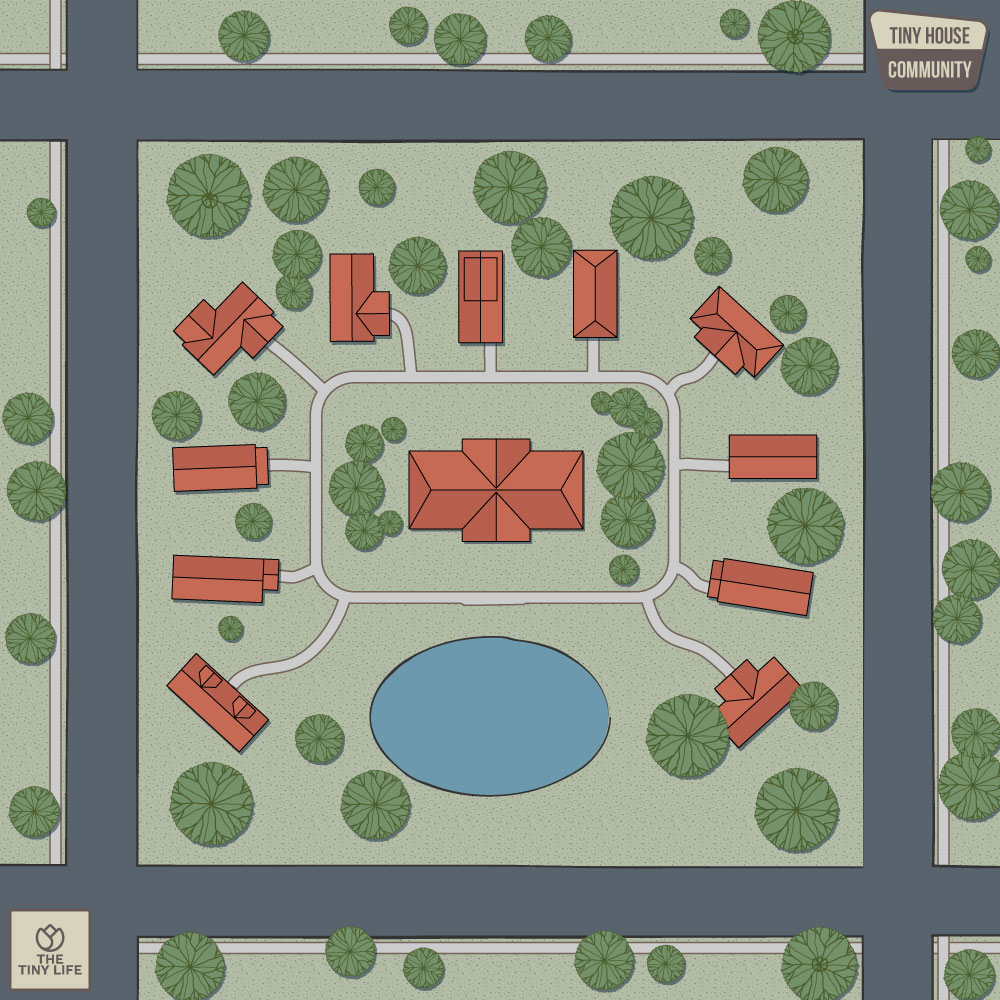
This setup also has an interconnected, communal feel. All of the homes face each other in a circle to cater to that feeling. The only difference between this setup and the previous lake layout is the community center is in the middle of the community, while the lake is off to the side.
Tiny House Communities You Can Join Today

If you aren’t ready to start you own tiny house community, consider joining one that already exists! Find a tiny house community in your state or find a tiny house community near you!
Your Turn!
- Why do you want to build a tiny house community?
- What steps do you need to take to develop your tiny house community?







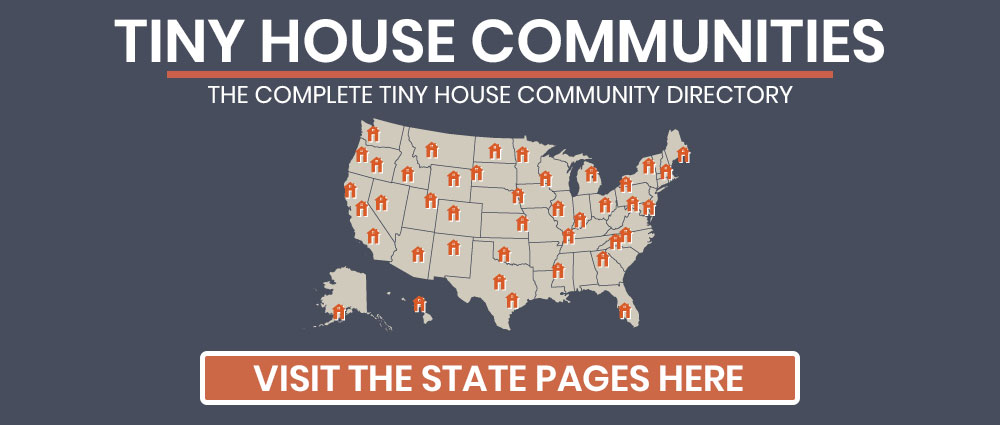
Wisconsin is NOT friendly to tiny home communities. Its rather sad, but if I had the money, I’d like to buy land and start one of these communities. People who are neat and quiet and want this type of life.
Nice 👍
Tiny homes 🏡 are perfect to have affordable
Maintenance and consistent to do important
Maintenance of peaceful in a quiet nice
Country area.
I live in Southern California and would love to find a tiny house community in Temecula , Ca 92591!
A community for seniors that want less responsible and lives a minimalist lifestyle….less expensive but good quality of life!
Can u make that happen here?
So many more people have tuned in to this style, . Whom would I have to speak with in order to get this established asap! Please & Thank You!
Please help me find the right Steps in order to find a a tiny house community in Riverside County, Temecula, Ca 92591!
I have decided that tiny living is for me in my next life chapter,
But I am also wanting my house to be on a foundation not wheels, Can you please provide me with a list of Tiny House Communities in Florida, to place it on once completed.
Looking to open up my tiny house community very interested and it’s been on my heart for years my name is Richard Martins I please just need some guidance I have a lot of knowledge on building with zoning codes I just moved to a new area and I have the property needed for it I just need some help and to get in touch with people that want to live in the community with myself thank you so much for your time
This was an awesome read as i want to set up one in Pennsylvania. I would have liked to hear how to go about creating the bylaws for the community as well.
I’d like to start a tiny home community through my nonprofit, for the homeless. Any ideas about funding or how to get started?
We own about 100 acres of land in north Florida with a large pond and 5 acre island that is accessible by a land bridge. I’d like to be able to set up a tiny home community with each lot being lakefront. I just don’t know where to start!
Looking for tiny house parking in the Houston, TX area. Any info is appreciated.
7/11/23 🤗 I love your work and ideas and the quality of what you publish Ryan. I am a lawyer so naturally I think like one and my primary specialties, among other subjects, have been over the past > 45 years in 3 key areas: Insurance defense /risk management and various involvement in land use planning, developing and “Cluster Housing” where the blueprints and plats and drawings can sure resemble (in much more detail, of course) some of your tiny house community graphics.
(And more of my interests over 50 years: co-housing – I personally lived for a while in a giant “student boarding house operated by the Methodist Church in Gainesville, FL when in college, “intentional housing”- almost like the old “communes” but now much “classier and safer”, and affordable housing. AND I LOVE TINY HOMES, manufactured housing, RV’s, Skoolies, ADU’s etc., etc.)
Why am I writing? Because I have NOT yet read your Tiny House Community article BUT when I do I hope I see sections about insurance for both the community and homeowners—there are all kinds of special programs and ideas for proper and affordable insurances, the involvement of architects, utility planning in partnership with municipalities, land use planning, lighting and other electrical planning, “catastrophe”, “succession planning” for residents and those “governing”, alcohol and drug rules, injury and aging planning”, issues pertaining to kids for a variety of reasons, “conflict resolution planning”, landscaping experts, plans for forging proper relationships with politicians and local governments, the involvement of land-use planning and zoning lawyers and even Lobbyists to get plans approved, ordinances, statutes, codes and ordinances changed, PR and advertising /marketing people if you’re going big, etc.
(With the help of proper professionals, even driveways, street lights, traffic lights and “signage” may need to planned to code and approved.
You may want a day care or businesses operating in homes where licenses may be needed, may want community internet, you will need garbage and fe-cycling services, need “governance”- planning and on-going, need liaisons with “the outside world”, need security, sidewalks. [There may be rules for most of the ideas here and for very good reasons.])
The idea is not so much to “go corporate”, per se, but to convert the world to the idea that smaller can be better and your goals should be to make the rest of the world or community around you know that you are going to be a good neighbor, be safe, secure, non-threatening, “not a cult”, attractive, welcoming, and that they should join you or at officially, “tolerate and think kindly” of your community so that you will make your residents and prospective residents feel the same way.
Thank you for considering all of my ideas here. I’ve had a long time thinking about them and started at 20 being on the U of F President’s —then Stephen C. O’Connell— committee for affordable housing. (And (NO, I am not advertising for a job or on behalf of any law firm or lobbyist. But I do think there should be “tiny house community” law firms that specialize in coordinating all of the above.)
Roughly how much land does the eight home configuration with parking in on the side take up?
https://thetinylife.com/wp-content/uploads/2022/03/Tiny-House-Neighborhood-Plans.jpg
Hi I live in Philadelphia & I just finished building a 24 foot trailer Tiny House & I love would to build a community of all tiny houses.
I am interested in building a tiny home community 6-8 homes
I want to start a tiny home community with homes on permanent foundations and 400-500 square feet. Curious what the estimated cost would be develop acreage to accommodate 20 -30 tiny homes on 10 acres with a common area consisting of a a club house and 2 Pickleball courts
What program did you use to draw the different style communities with or who should I look for to draw my idea of a village on the parcel that I own? I had a designer who did a preliminary drawing, but then he got busy and I haven’t been able to get him to adjust the changes in the original drawing he did for me.